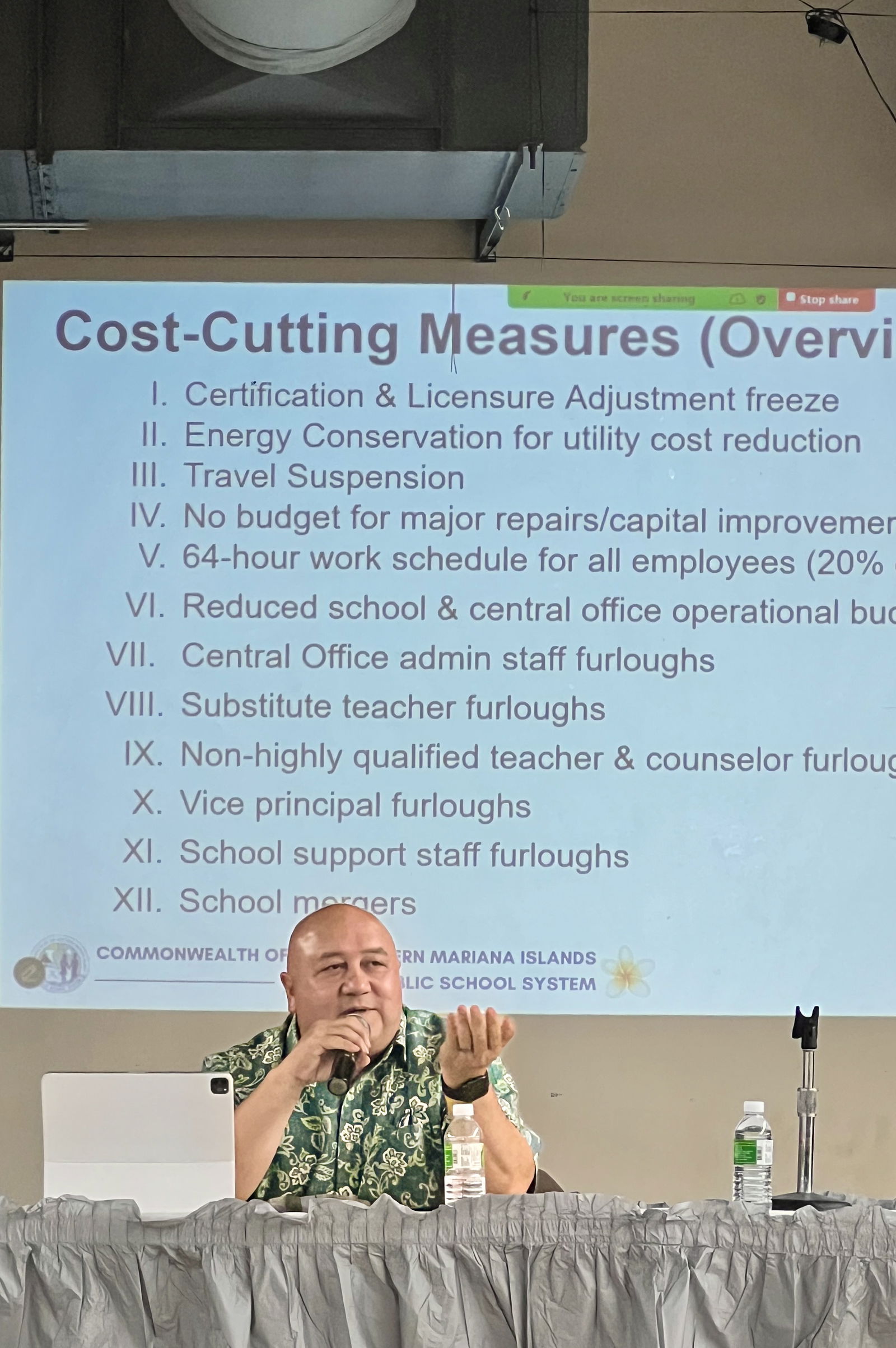
Commissioner of Education Dr. Lawrence F. Camacho kicked off the Public School System’s town hall meeting at Chacha Ocean View Middle School on Tuesday evening to address PSS’s looming fiscal cliff. On Thursday evening, he hosted a town hall meeting for southern school clusters at Koblerville Elementary School.
THE CNMI is going to “step backwards” in education, Commissioner of Education Dr. Lawrence F. Camacho said on Wednesday, because the Public School System will have to implement “no-school Mondays” beginning Oct. 1, 2025, if the fiscal year 2026 budget allocates only $31.7 million for PSS.
The reduction of instructional days from 180 to 150 through an emergency declaration is among the “worst-case scenarios” that Camacho presented to parents and teachers during a PSS town hall meeting in the Marianas High School cafeteria Wednesday night.
Beginning Oct. 1, 2025, PSS will implement austerity Mondays, which means no classes for students and no work for school staff every Monday.
PSS had submitted a $49.2 million budget request for the next fiscal year. But then-Gov. Arnold I. Palacios, in his budget submission, proposed $40 million.
In August, the House of Representatives passed a $127.4 million appropriation measure that allocates only $31.7 million for PSS. The House Ways and Means Committee chairman, Rep. John Paul P. Sablan, said once a $29 million loan from the Marianas Public Land Trust is secured, the late governor’s $147.5 million budget proposal would be restored, along with the $40 million for PSS.
On Friday, the House was unable to act on the $29 million MPLT loan bill because it lacked the two-thirds majority (14 votes) required. MPLT trustees had also requested the inclusion of a new provision to allow flexibility in collateralizing securities.
“I’m hopeful that we get the $40 million,” Camacho told the 180 parents and teachers who attended the meeting in person and the 129 who joined online.
Cost-cutting measures
Aside from the 64-hour work schedule across the entire school district, PSS will also have to furlough vice principals, substitute teachers, counselors, school support employees, and central office staff, Camacho said. PSS will likewise freeze certification and licensure adjustments, suspend travel, reduce school and central office operations, and hold off major repairs and capital improvement projects.
PSS is also considering merging schools.
Acting PSS Finance Director Jonathan Aguon said that in trying to adjust to the proposed $31.7 million education budget, they looked at “every avenue” to cut, hoping to avoid furloughs because “we value [our employees], as every one of them plays a key role in the operation of the schools.”
But, he added, even for payroll alone, the $31.7 million is “really insufficient.” So they identified other categories to cut and calculated the potential savings.
Furloughing central office staff would save $199,502.
Furloughing substitute teachers would save $1.3 million.
Furloughing non-certified teachers would save $1.1 million.
Furloughing counselors would save $110,000.
Furloughing vice principals would save $1.1 million.
Furloughing school support staff would save $1.1 million.
Merging middle schools would save $695,500.
Altogether, these cuts would total $5.8 million in savings, Aguon said.
Camacho said the 64-hour work schedule will affect all locally and federally funded employees. He added that PSS is not allowed to supplant locally funded salaries with federal funds.
The impact, he said, will include larger class sizes, reduced instructional and counseling support, diminished school administration capacity, increased staff stress and burnout, delays in services, and possible risks to accreditation.
“Can you imagine running schools now, going backwards? We don’t want to do any of these cost-cutting measures, but we’re going to have to with the $31.7 million budget. It is no longer going to be a fun thing to have because we are stepping backwards,” Camacho said.
Nevertheless, he added, “I am a very hopeful person. I’m always positive in the way I think. But when these become real, I’m not going to be the only one impacted by it, but many — the entire school district. And I am going to be real with you as well.”
What they are trying to do now, the commissioner said, is address the problem before it arrives on Oct. 1, 2025.
“That is what I’m trying to do now — I’m trying to be transparent, I’m trying to make sure you understand it, the community understands the impact of what this could be in a worst-case scenario. And I’m hopeful that we get the $40 million,” he said.
Ainsley Ancheta, a senior student at MHS, asked, “If we don’t have Mondays to study as we normally do, how can we prepare for the upcoming school year?”
Camacho replied: “I totally get it. That is why we are discussing this now. We are not going to wait until the last minute to tell students what’s going on. You need to hear about it now so we take that into consideration.”
He vowed that despite these unprecedented challenges, PSS remains committed to placing students first. The difficult measures, he said, will be implemented to safeguard core instructional programs and preserve learning integrity.











